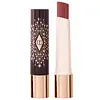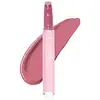What's inside
What's inside
 Key Ingredients
Key Ingredients

 Benefits
Benefits

 Concerns
Concerns

 Ingredients Side-by-side
Ingredients Side-by-side

Diisostearyl Malate
EmollientBis-Behenyl/Isostearyl/Phytosteryl Dimer Dilinoleyl Dimer Dilinoleate
EmollientBis-Diglyceryl Polyacyladipate-2
EmollientHydrogenated Polyisobutene
EmollientCeresin
Emulsion StabilisingOctyldodecanol
EmollientSynthetic Wax
AbrasivePentaerythrityl Tetraisostearate
Emollient1,2-Hexanediol
Skin ConditioningDisteardimonium Hectorite
StabilisingSodium Hyaluronate
HumectantPassiflora Edulis Seed Oil
EmollientTheobroma Grandiflorum Seed Butter
Skin ConditioningPalmitoyl Hexapeptide-12
Skin ConditioningParfum
MaskingTocopheryl Acetate
AntioxidantPropylene Carbonate
SolventCaprylic/Capric Triglyceride
MaskingC10-18 Triglycerides
EmollientTriolein
Skin ConditioningTriethoxycaprylylsilane
Stearalkonium Hectorite
Gel FormingGlyceryl Dioleate
EmollientCI 77891
Cosmetic ColorantIron Oxides
CI 15850
Cosmetic ColorantDiisostearyl Malate, Bis-Behenyl/Isostearyl/Phytosteryl Dimer Dilinoleyl Dimer Dilinoleate, Bis-Diglyceryl Polyacyladipate-2, Hydrogenated Polyisobutene, Ceresin, Octyldodecanol, Synthetic Wax, Pentaerythrityl Tetraisostearate, 1,2-Hexanediol, Disteardimonium Hectorite, Sodium Hyaluronate, Passiflora Edulis Seed Oil, Theobroma Grandiflorum Seed Butter, Palmitoyl Hexapeptide-12, Parfum, Tocopheryl Acetate, Propylene Carbonate, Caprylic/Capric Triglyceride, C10-18 Triglycerides, Triolein, Triethoxycaprylylsilane, Stearalkonium Hectorite, Glyceryl Dioleate, CI 77891, Iron Oxides, CI 15850
Diisostearyl Malate
EmollientPhytosteryl/Isostearyl/Cetyl/Stearyl/Behenyl Dimer Dilinoleate
Skin ConditioningBis-Diglyceryl Polyacyladipate-2
EmollientPolyglyceryl-2 Triisostearate
EmulsifyingHydrogenated Polyisobutene
EmollientCeresin
Emulsion StabilisingMicrocrystalline Wax
Emulsion Stabilising1,2-Hexanediol
Skin ConditioningParfum
MaskingBenzyl Benzoate
AntimicrobialTocopheryl Acetate
AntioxidantPassiflora Edulis Seed Oil
EmollientBenzyl Alcohol
PerfumingVitis Vinifera Seed Oil
EmollientEuterpe Oleracea Fruit Extract
Punica Granatum Fruit Extract
AntioxidantLycium Barbarum Fruit Extract
AstringentMalpighia Punicifolia Fruit Extract
AntioxidantPassiflora Incarnata Flower Extract
Skin ConditioningCitrus Limon Fruit Extract
MaskingCitrullus Lanatus Fruit Extract
Skin ConditioningFragaria Vesca Fruit Extract
AstringentVaccinium Angustifolium Fruit Extract
Skin ProtectingPrunus Persica Fruit Extract
AbrasiveVaccinium Macrocarpon Fruit Juice
Skin ConditioningTocopherol
AntioxidantCI 45410
Cosmetic ColorantCI 15985
Cosmetic ColorantCI 77891
Cosmetic ColorantCI 15850
Cosmetic ColorantIron Oxides
CI 42090
Cosmetic ColorantDiisostearyl Malate, Phytosteryl/Isostearyl/Cetyl/Stearyl/Behenyl Dimer Dilinoleate, Bis-Diglyceryl Polyacyladipate-2, Polyglyceryl-2 Triisostearate, Hydrogenated Polyisobutene, Ceresin, Microcrystalline Wax, 1,2-Hexanediol, Parfum, Benzyl Benzoate, Tocopheryl Acetate, Passiflora Edulis Seed Oil, Benzyl Alcohol, Vitis Vinifera Seed Oil, Euterpe Oleracea Fruit Extract, Punica Granatum Fruit Extract, Lycium Barbarum Fruit Extract, Malpighia Punicifolia Fruit Extract, Passiflora Incarnata Flower Extract, Citrus Limon Fruit Extract, Citrullus Lanatus Fruit Extract, Fragaria Vesca Fruit Extract, Vaccinium Angustifolium Fruit Extract, Prunus Persica Fruit Extract, Vaccinium Macrocarpon Fruit Juice, Tocopherol, CI 45410, CI 15985, CI 77891, CI 15850, Iron Oxides, CI 42090
Ingredients Explained
These ingredients are found in both products.
Ingredients higher up in an ingredient list are typically present in a larger amount.
1,2-Hexanediol is a synthetic liquid and another multi-functional powerhouse.
It is a:
- Humectant, drawing moisture into the skin
- Emollient, helping to soften skin
- Solvent, dispersing and stabilizing formulas
- Preservative booster, enhancing the antimicrobial activity of other preservatives
This ingredient is lipid-based synthetic skin-conditioning agent derived from adipic acid and a mixture of fatty acids. It is often called a lanolin substitute.
As an emollient, it helps soften and hydrate the skin. Emollients create a barrier on the skin to trap moisture in.
Due to its fatty acid base, it may not be Malassezia folliculitis safe.
Learn more about Bis-Diglyceryl Polyacyladipate-2Ceresin is a wax derived from ozokerite. It is an alternative to beeswax.
The most common process of creating ceresin is by using heat and sulfuric acid.
Ci 15850 is the pigment color red. It is an azo dye and created synthetically.
Azo dyes need to be thoroughly purified before use. This allows them to be more stable and longer-lasting.
This ingredient is common in foundations, lipsticks, and blushes. This color is described as brown/orangey red.
It has many secondary names such as Red 6 and Red 7. According to a manufacturer, Red 6 usually contains aluminum.
Learn more about CI 15850Ci 77891 is a white pigment from Titanium dioxide. It is naturally found in minerals such as rutile and ilmenite.
It's main function is to add a white color to cosmetics. It can also be mixed with other colors to create different shades.
Ci 77891 is commonly found in sunscreens due to its ability to block UV rays.
Learn more about CI 77891Diisostearyl Malate is an emollient and most often used in lip products. It comes from isostearyl alcohol, a fatty acid, and malic acid, an AHA.
As an emollient, Diisostearyl Malate helps create a thin film on your skin to trap moisture in. This helps keep your skin soft and smooth.
Hydrogenated Polyisobutene is a synthetic polymer. Polymers are compounds with high molecular weight. Hydrogenated Polyisobutene is an emollient and texture enhancer.
In one study, Hydrogenated Polyisobutene showed better skin hydration levels than Caprylic/Capric Triglyceride. As an emollient, it helps keep your skin soft and hydrated by trapping moisture in.
Hydrogenated Polyisobutene is often used as a mineral oil replacement.
Learn more about Hydrogenated PolyisobuteneParfum is a catch-all term for an ingredient or more that is used to give a scent to products.
Also called "fragrance", this ingredient can be a blend of hundreds of chemicals or plant oils. This means every product with "fragrance" or "parfum" in the ingredients list is a different mixture.
For instance, Habanolide is a proprietary trade name for a specific aroma chemical. When used as a fragrance ingredient in cosmetics, most aroma chemicals fall under the broad labeling category of “FRAGRANCE” or “PARFUM” according to EU and US regulations.
The term 'parfum' or 'fragrance' is not regulated in many countries. In many cases, it is up to the brand to define this term.
For instance, many brands choose to label themselves as "fragrance-free" because they are not using synthetic fragrances. However, their products may still contain ingredients such as essential oils that are considered a fragrance by INCI standards.
One example is Calendula flower extract. Calendula is an essential oil that still imparts a scent or 'fragrance'.
Depending on the blend, the ingredients in the mixture can cause allergies and sensitivities on the skin. Some ingredients that are known EU allergens include linalool and citronellol.
Parfum can also be used to mask or cover an unpleasant scent.
The bottom line is: not all fragrances/parfum/ingredients are created equally. If you are worried about fragrances, we recommend taking a closer look at an ingredient. And of course, we always recommend speaking with a professional.
Learn more about ParfumPassiflora Edulis Seed Oil is an oil and isn't fungal acne safe.
Tocopheryl Acetate is AKA Vitamin E. It is an antioxidant and protects your skin from free radicals. Free radicals damage the skin by breaking down collagen.
One study found using Tocopheryl Acetate with Vitamin C decreased the number of sunburned cells.
Tocopheryl Acetate is commonly found in both skincare and dietary supplements.
Learn more about Tocopheryl AcetateThis ingredient is a combination of red, black, and yellow iron oxide pigments. This combination of colors is usually found in foundation, because it results in a "skin" color.